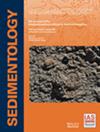南海海底峡谷的河床演化:自主水下航行器调查的新见解
IF 2.8
2区 地球科学
Q1 GEOLOGY
引用次数: 0
摘要
传统的海底峡谷地形测绘依赖于船载和拖曳传感器,但其细尺度地貌和浅层结构需要更高分辨率的数据集。本研究利用自主水下航行器获得的高分辨率数据集,结合地震反射剖面和沉积物岩心,分析了南海北部25.6公里长的海底峡谷(峡谷C14)内的床型集。沿着峡谷拍摄了一系列新月形的轴向台阶,表明由超临界浊度流形成的循环台阶。上层的轴向台阶分别在背风侧和背风侧表现出侵蚀截断和亚水平反射,表明这是由具有高侵蚀能力的受限流形成的侵蚀-沉积旋回台阶。峡谷狭窄和更陡的轴向坡度促进了这一点。经过一个过渡段后,下层变宽,轴向梯度变缓,导致轴向台阶的不对称性和波长增加。这些台阶的应力侧的背向层状沉积表明沉积旋回台阶具有较高的沉积强度。泥沙填充物,几乎填满了与冲刷相关的每一个旋回台阶,这表明,由峡谷侧壁和上游背风面的不稳定过程提供的重力流,以及可能由陆架边缘和最上层斜坡溢出到峡谷中,对先前形成的河床进行了改造。在最底层,循环台阶转变为沟田,可能与峡谷底加宽导致流速降低和坡度进一步减小有关。水流编织和再收敛与峡谷底细粒沉积物的侵蚀有关,应该在超临界条件下产生沟槽。这项工作增强了我们对深水海底峡谷的详细形态和浅地形配置的理解,为它们的成因过程和演化提供了见解。本文章由计算机程序翻译,如有差异,请以英文原文为准。
Bedform evolution along a submarine canyon in the South China Sea: New insights from an autonomous underwater vehicle survey
ABSTRACT Traditional mapping of bedforms in submarine canyons relied on vessel‐mounted and towed sensors, but their fine‐scale geomorphology and shallow structure requires higher resolution datasets. This study utilizes a high‐resolution dataset obtained from an autonomous underwater vehicle, combined with seismic reflection profiles and sediment cores, to analyze bedform sets within a 25.6 km long submarine canyon (canyon C14) in the northern South China Sea. A train of crescent‐shaped axial steps, indicative of cyclic steps formed by supercritical turbidity currents, is imaged along the canyon. Axial steps in the upper course show erosional truncations and sub‐horizontal reflectors on the lee and stoss sides, respectively, pointing to erosional–depositional cyclic steps formed by confined flows with high erosional capacity. This is facilitated by canyon narrowness and steeper axial gradient. After a transition segment, the lower course widens, with a gentler axial gradient, resulting in increased asymmetry and wavelength of axial steps. Backset bed deposits on the stoss sides of these steps indicate depositional cyclic steps with higher aggradation. Sediment filling, almost padding each cyclic step associated scour suggests the reworking of previously formed bedforms by gravity flows fed by destabilization processes on the canyon sidewalls and upstream lee faces and, possibly, by shelf‐edge and uppermost slope spillover into the canyon. At the lowermost course, cyclic steps transition to a furrow field, likely associated to flow velocity reduction facilitated by canyon floor widening and a further decrease in slope gradient. Flow braiding and re‐convergence, related to the erosion of fine‐grained deposits within the canyon floor, should have played a role to produce furrows under supercritical conditions. This work enhances our understanding of the detailed morphology and shallow relief configuration of bedforms in deep‐water submarine canyons, providing insights into their causative processes and evolution.
求助全文
通过发布文献求助,成功后即可免费获取论文全文。
去求助
来源期刊

Sedimentology
地学-地质学
CiteScore
8.20
自引率
11.40%
发文量
94
审稿时长
6-12 weeks
期刊介绍:
The international leader in its field, Sedimentology publishes ground-breaking research from across the spectrum of sedimentology, sedimentary geology and sedimentary geochemistry.
Areas covered include: experimental and theoretical grain transport; sediment fluxes; modern and ancient sedimentary environments; sequence stratigraphy sediment-organism interaction; palaeosoils; diagenesis; stable isotope geochemistry; environmental sedimentology
 求助内容:
求助内容: 应助结果提醒方式:
应助结果提醒方式:


